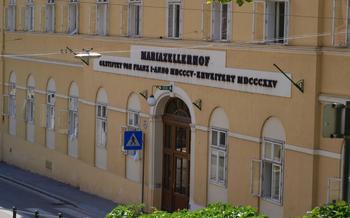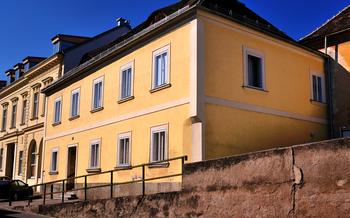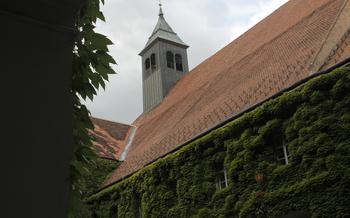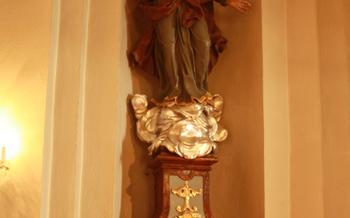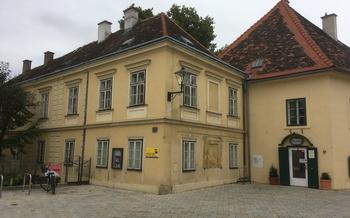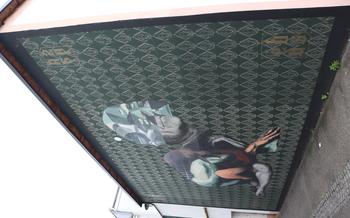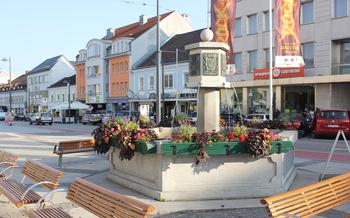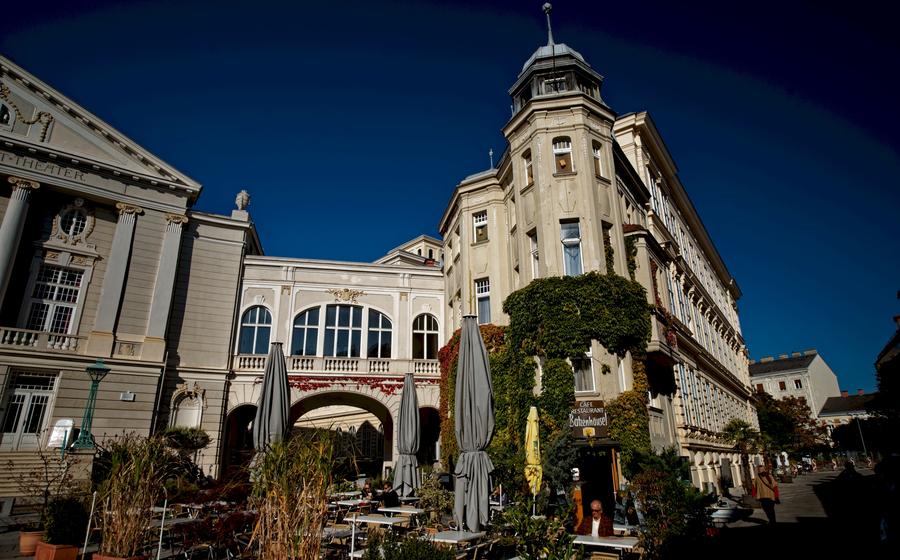
Museum Klosterneuburg
- History of Klosterneuburg Monastery
- St. Leopold's Chapel
- Verdun Altar
- Historical Significance and Religious Importance
- Symbolism and Iconography
- Gothic Cloister
- Treasury
- Wine Cellar
- Monastery Gardens
- Guided Tours
- Opening Hours and Admission
- Getting There
- Nearby Attractions
- Accessibility
- Photography and Videography
- Food and Drinks
- Insider Tip: Unveiling Hidden Gems and Unique Experiences
History of Klosterneuburg Monastery
The Augustine canons founded the Klosterneuburg Monastery in 1114, under the patronage of Margrave Leopold III of Babenberg. It played a significant role as the spiritual and economic heart of the Babenberg dynasty, the rulers of Austria during the Middle Ages. The monastery complex underwent several expansions and modifications over the centuries, reflecting different architectural styles and the evolving needs of the monastic community.
During the 12th century, the Romanesque style dominated the monastery's architecture, evident in the original abbey church, which was consecrated in 113In the 13th century, Gothic elements were introduced, particularly in the construction of the Gothic cloister and the expansion of the abbey church. The 14th century marked the transition to a more refined Gothic style, as seen in the construction of St. Leopold's Chapel, a masterpiece of Gothic architecture.
The 17th and 18th centuries brought about significant Baroque renovations, led by the renowned architect Jakob Prandtauer. The abbey church's interior was adorned with elaborate Baroque decorations, including the magnificent high altar, while the monastery's facade was redesigned in the Baroque style. These renovations transformed Klosterneuburg into a stunning example of Baroque architecture, further enhancing its cultural and historical significance.
St. Leopold's Chapel
Nestled within the heart of Klosterneuburg Monastery, St. Leopold's Chapel stands as an architectural marvel, embodying the fusion of Romanesque and Gothic styles. Constructed in the 13th century, this sacred space is dedicated to Saint Leopold III, the founder of the Babenberg dynasty and a revered figure in Austrian history.
The chapel's intricate design captivates visitors with its vaulted ceilings adorned with vibrant frescoes and stained glass windows that bathe the interior in an ethereal glow. The walls are embellished with meticulously crafted sculptures, each narrating a chapter from the life of Saint Leopold and other biblical figures.
Beyond its artistic splendor, St. Leopold's Chapel holds immense historical significance. It served as the final resting place of the Babenberg rulers, their mortal remains interred within the chapel's crypt. This sacred chamber has borne witness to centuries of prayers, ceremonies, and the unwavering devotion of generations of pilgrims.
As a testament to its enduring legacy, St. Leopold's Chapel remains a spiritual sanctuary, attracting visitors from far and wide who seek solace, inspiration, and a glimpse into Austria's rich history.
Verdun Altar
The Verdun Altar, also known as the Altar of St. Nicholas, is one of the most significant and awe-inspiring treasures of Klosterneuburg Monastery. Created in the early 12th century by the renowned goldsmith Nicholas of Verdun, this exquisite masterpiece is a testament to his extraordinary skill and artistry. Constructed from silver-gilt, copper, enamel, and precious stones, the altar features intricate carvings, delicate filigree work, and vibrant enamel colors that captivate the eyes of visitors.
Historical Significance and Religious Importance
The Verdun Altar holds immense historical and religious significance. Commissioned by Provost Hartmann of Klosterneuburg, it was intended to serve as the centerpiece of the monastery's church. The altar's creation coincided with a period of great spiritual and artistic fervor within the monastery, and it quickly became a symbol of the monastery's wealth and prestige. The altar's dedication to St. Nicholas, the patron saint of merchants and travelers, reflects the close ties between the monastery and the trade routes that passed through the region.
Symbolism and Iconography
The Verdun Altar is a treasure trove of Christian symbolism and iconography. Its central panel depicts the crucifixion of Jesus Christ, flanked by scenes from his life and the lives of saints. The altar's intricate details reveal a deep understanding of biblical narratives and theological concepts. The use of precious materials and vibrant colors adds to the altar's symbolic significance, representing the divine and eternal nature of God's love and sacrifice.
The Verdun Altar is not just a work of art; it is a sacred object that has witnessed centuries of prayer, devotion, and contemplation. It continues to inspire awe and reverence among visitors, serving as a reminder of the enduring power of faith and the beauty of religious expression.
Gothic Cloister
The Gothic Cloister, nestled within the heart of Klosterneuburg Monastery, stands as a testament to the architectural prowess of the Middle Ages. Constructed during the 14th century, this serene sanctuary exudes an aura of tranquility and elegance. Its graceful arches, intricate carvings, and delicate tracery create a harmonious ensemble that transports visitors back in time.
Originally serving as a place of contemplation and reflection for the Augustinian canons who resided in the monastery, the Gothic Cloister today invites visitors to wander amidst its serene surroundings. The cloister's central courtyard, adorned with manicured lawns and vibrant flowerbeds, offers a tranquil oasis amidst the monastery's bustling activity.
As you stroll along the cloister's arcaded walkways, take a moment to admire the exquisite craftsmanship that adorns its every corner. The intricately carved capitals, depicting biblical scenes and mythical creatures, showcase the artistic prowess of the medieval artisans who painstakingly created this architectural masterpiece.
While the Gothic Cloister primarily served as a place of contemplation for the monks, it also played a vital role in the monastery's daily life. The cloister's east wing housed the chapter house, where the canons convened to discuss important matters pertaining to the monastery's governance and discipline. The west wing, on the other hand, provided access to the refectory, where the monks gathered for their communal meals.
Step into the Gothic Cloister and allow yourself to be enveloped by its serene atmosphere. As you wander through its graceful arches and admire the intricate details that adorn its walls, you will gain a deeper appreciation for the architectural and spiritual legacy of Klosterneuburg Monastery.
Treasury
The Treasury of Klosterneuburg Monastery houses a magnificent collection of religious artifacts and ecclesiastical treasures that hold immense historical and cultural significance. Among the highlights of the collection are:
-
The Reliquary of St. Leopold: This exquisite reliquary, crafted in the 13th century, holds the relics of St. Leopold, the patron saint of Austria. It is adorned with intricate goldsmith work, precious stones, and enamel decorations.
-
The Verdun Altar: This masterpiece of medieval goldsmithing, created in the 12th century, is one of the most celebrated treasures of the monastery. It consists of 51 enamel plaques depicting scenes from the life of Christ and the Virgin Mary, set in a stunning gold frame.
-
The Imperial Crown of Austria: The treasury also displays the Imperial Crown of Austria, which was used for the coronation of the Holy Roman Emperors. This magnificent crown, made of gold, silver, and precious stones, is a symbol of the Habsburg dynasty's power and prestige.
-
The Burgundian Tapestries: A series of finely woven tapestries from the 15th century, depicting scenes from the life of Moses, adds to the richness of the collection. These tapestries are renowned for their intricate designs, vibrant colors, and historical significance.
Visitors to the Treasury can marvel at these exquisite artifacts and gain insights into the history, culture, and religious traditions of Austria. Guided tours are available to provide a deeper understanding of the significance of these treasures.
Wine Cellar
The monastery's wine cellar is a treasure trove for wine enthusiasts, boasting an extensive collection of Austrian wines that reflects the region's rich viticulture tradition. With its historical significance and cultural importance, the wine cellar offers a unique glimpse into the monastery's past and its connection to the local winemaking industry. Visitors can marvel at the vast array of bottles, each representing a different vintage and grape variety, carefully stored in the cellar's cool and humid environment. Guided tours provide insights into the history of winemaking in the region, the different grape varieties cultivated, and the winemaking process. Visitors can also participate in wine tasting sessions, where they can sample a selection of the monastery's finest wines and learn about their unique characteristics and flavors.
Monastery Gardens
The monastery grounds encompass a sprawling expanse of meticulously landscaped gardens that exude tranquility and serene beauty. These verdant havens have a rich historical significance, meticulously cultivated over centuries by the monks who resided here. Visitors can wander through the gardens, immersing themselves in the vibrant tapestry of colors and fragrances that greet their senses.
The gardens showcase a diverse array of plant species, including delicate roses, vibrant tulips, and fragrant herbs. Each season brings its own unique charm to the gardens, transforming them into a kaleidoscope of colors. In spring, the grounds burst into life with a profusion of colorful blooms, while summer unveils a verdant paradise brimming with lush foliage. Autumn paints the gardens in shades of gold and crimson, and winter casts a tranquil blanket of snow, creating a magical winter wonderland.
Beyond their aesthetic appeal, the monastery gardens also hold horticultural significance. The monks have a long-standing tradition of cultivating medicinal plants and herbs, using them for healing purposes and to create natural remedies. Visitors can learn about the medicinal properties of various plants and discover the secrets of the monastery's ancient herbal traditions.
Strolling through the serene paths of the monastery gardens offers a unique opportunity to connect with nature, find inner peace, and appreciate the beauty of the natural world. Whether seeking a tranquil retreat or an educational experience, visitors will find solace and inspiration within these enchanting gardens.
Guided Tours
The Museum Klosterneuburg offers a variety of guided tours that provide visitors with an immersive and informative experience. These tours are led by knowledgeable and enthusiastic guides who are passionate about sharing the rich history and significance of the monastery.
Standard Guided Tour: This tour covers the highlights of the monastery, including the St. Leopold's Chapel, the Verdun Altar, the Gothic Cloister, and the Treasury. Visitors will learn about the history, architecture, and religious significance of these spaces.
Thematic Tours: In addition to the standard tour, the museum also offers thematic tours that focus on specific aspects of the monastery. These tours may explore the history of the Augustinian canons, the viticulture tradition of the monastery, or the artistic treasures of the collection.
Tailor-Made Tours: For groups or individuals with specific interests, the museum can arrange tailor-made tours that cater to their needs. These tours can be customized to focus on specific areas or themes, ensuring a personalized and enriching experience.
Booking and Reservations: Guided tours can be booked in advance through the museum's website or by phone. Reservations are recommended, especially for groups, to ensure availability and avoid disappointment.
Opening Hours and Admission
Opening Hours
- Tuesday to Sunday: 10:00 AM - 5:00 PM
- Closed on Mondays and public holidays
Admission
- Adults: €12
- Seniors (65+): €10
- Children (6-18): €6
- Families (2 adults + 2 children): €30
Discounts
- Groups of 10 or more: 10% discount
- Students with valid ID: 50% discount
- Free admission for children under 6 years old
Accessibility
- The monastery is wheelchair accessible.
- Guided tours in sign language are available upon request.
- Braille guides and audio descriptions are available for the visually impaired.
Visitor Information
- The monastery offers a variety of guided tours in different languages.
- Audio guides are available for rent in English, German, French, Italian, and Spanish.
- The monastery has a gift shop where you can purchase souvenirs, books, and religious items.
- A café is located on the monastery grounds, where you can enjoy a light meal or snack.
Getting There
Reaching Klosterneuburg Monastery is a breeze, thanks to its convenient location just a short distance from the heart of Vienna. Whether you prefer the ease of public transportation, the freedom of driving your own vehicle, or the guided comfort of a tour group, there are several options to choose from.
Public Transportation:
Hop on the S-Bahn (rapid transit) line S40 and alight at the Klosterneuburg-Kierling station. From there, it's a pleasant 10-minute walk to the monastery. Alternatively, you can take bus number 239 from the Heiligenstadt U-Bahn station and get off at the Klosterneuburg Stiftsplatz stop, right outside the monastery's entrance.
Driving:
If you're driving, simply follow the A22 Donauufer Autobahn (Danube Riverbank Freeway) and take exit 4 (Klosterneuburg). From there, it's a straightforward drive to the monastery, located just off the main road. Ample parking spaces are available on-site for a small fee.
Guided Tours:
For a hassle-free and informative experience, consider joining a guided tour. Many tour operators in Vienna offer day trips or half-day excursions to Klosterneuburg Monastery, often combined with visits to other nearby attractions. These tours typically include transportation, guided commentary, and skip-the-line access, ensuring a smooth and enriching visit.
For further details on schedules, fares, and booking information, please visit the monastery's official website or contact the local tourism office.
Nearby Attractions
The Museum Klosterneuburg is situated in close proximity to several other noteworthy attractions, offering the opportunity for a diverse and enriching cultural experience. Visitors can explore the historic Heiligenstadt, where Ludwig van Beethoven composed some of his most renowned works. The picturesque town of Dürnstein, with its charming cobblestone streets and medieval flair, is another must-see destination, immortalized by the tale of Richard the Lionheart's imprisonment.
For those fascinated by military history, the nearby Heeresgeschichtliches Museum (Army History Museum) unveils the rich heritage of the Austrian military. Moreover, the Essl Museum, dedicated to contemporary art, showcases a collection of remarkable artworks from renowned Austrian and international artists.
Complementing these cultural attractions, the region offers an array of outdoor activities for nature enthusiasts. The nearby Donau-Auen National Park invites visitors to explore its pristine landscapes, teeming with diverse flora and fauna. The park provides a tranquil retreat for hiking, cycling, and birdwatching amidst the serene beauty of the Danube River.
Combining a visit to the Museum Klosterneuburg with these neighboring attractions creates a comprehensive and immersive cultural experience, allowing travelers to delve into the rich history, art, and natural wonders that the region has to offer.
Accessibility
The Museum Klosterneuburg is committed to providing a welcoming and accessible environment for visitors of all abilities. The monastery features ramps, elevators, and designated accessible routes throughout the premises, ensuring that everyone can explore and enjoy its wonders. Visitors with disabilities can request assistance from the friendly staff, who are always ready to provide guidance and support. Accessible restrooms are also available for the convenience of visitors. By prioritizing accessibility, the Museum Klosterneuburg creates an inclusive and enjoyable experience for everyone.
Photography and Videography
Photography: Visitors are permitted to take photographs for personal, non-commercial use within the monastery's public areas. However, the use of tripods and flash photography is generally not allowed to preserve the tranquility of the monastery's atmosphere and protect its delicate artifacts.
Videography: Filming or video recording within the monastery requires prior permission from the monastery authorities. Professional photography or videography for commercial purposes is typically not permitted without proper authorization.
Respectful Photography: Visitors are kindly requested to be respectful and mindful of the sacred and contemplative nature of the monastery when taking photographs or videos. It is important to avoid disturbing ongoing religious services, ceremonies, or the privacy of other visitors.
No Flash Photography: Using flash photography is strictly prohibited within the monastery's historic interiors, especially in the St. Leopold's Chapel and the Treasury, to protect the delicate artwork and religious artifacts from damage or fading.
Designated Photography Areas: Certain areas within the monastery may be designated as photography-free zones to maintain the sanctity and solemnity of the spaces. Please adhere to these restrictions and respect the signs or instructions provided by the monastery staff.
Food and Drinks
When visiting Klosterneuburg Monastery, a delightful array of dining options awaits you in the surrounding area. Indulge in traditional Austrian cuisine at charming restaurants, savor the flavors of international dishes at cozy cafes, or immerse yourself in the local culture at nearby Heurigen, traditional wine taverns offering regional specialties and locally produced wines.
For a memorable dining experience, we highly recommend Gasthof Bründlmayer, located just a short walk from the monastery. This family-run restaurant has been serving authentic Austrian cuisine for generations, featuring mouthwatering dishes such as Wiener Schnitzel, Tafelspitz (boiled beef), and delicious seasonal specialties.
If you prefer a lighter meal or a sweet treat, head to Café Konditorei Aumüller, renowned for its exquisite pastries and cakes. Enjoy a cup of freshly brewed coffee or tea, accompanied by tempting creations such as Sachertorte, Apfelstrudel, and Linzer Torte, all lovingly crafted by the skilled pastry chefs.
For a truly unique experience, consider packing a picnic and enjoying a leisurely meal in the tranquil surroundings of the monastery gardens. Spread out a blanket beneath the shade of ancient trees, savor the flavors of your homemade delicacies, and soak in the serene atmosphere of this historic site.
Whether you choose to dine at a restaurant, indulge in local specialties at a Heurigen, or enjoy a picnic in the gardens, the culinary delights of Klosterneuburg are sure to satisfy your taste buds and enhance your overall visit to this magnificent monastery.
Insider Tip: Unveiling Hidden Gems and Unique Experiences
Embrace the tranquility of the early morning hours to explore the monastery grounds before the crowds arrive. This serene ambiance provides an intimate encounter with the monastery's charm and history. Discover hidden corners, capture stunning photographs without distractions, and immerse yourself in the peaceful atmosphere.
Seek out the lesser-known gem of the monastery, the medieval herb garden. Nestled within the monastery walls, this tranquil haven showcases a variety of herbs used for medicinal and culinary purposes in the past. Stroll through the garden, inhale the aromatic scents, and learn about the fascinating history of herbal remedies.
For a truly unique experience, participate in one of the monastery's special events or workshops. Throughout the year, the monastery hosts various activities, such as guided meditation sessions in the gardens, wine tasting evenings in the cellar, and historical reenactments. These events offer a deeper insight into the monastery's rich heritage and provide a memorable and immersive experience.

